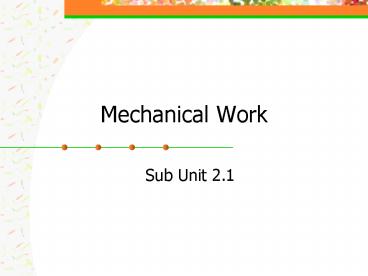Mechanical Work - PowerPoint PPT Presentation
1 / 9
Title:
Mechanical Work
Description:
Explain the relationship between work, force applied, and the distance an object ... When a torque causes rotational movement (like gears, pulleys, wheels, etc. ... – PowerPoint PPT presentation
Number of Views:35
Avg rating:3.0/5.0
Title: Mechanical Work
1
Mechanical Work
- Sub Unit 2.1
2
Objectives
- Define work done by a force or torque in a
mechanical system. - Explain the relationship between work, force
applied, and the distance an object moves. - Solve work problems, given force and distance
information in English and SI units. - Explain how efficiency relates to input work and
output work for a mechanical system. - Define radian measure of angles.
- Explain the relationship between work, torque
applied, and the angle (in radians) through which
and object moves. - Solve work problems, given torque and angle
information in English and SI units.
3
Work
- Linear
- When a force moves something a distance (like a
pushing a car, moving a desk, lifting weights,
etc.) - Rotational
- When a torque causes rotational movement (like
gears, pulleys, - wheels, etc.)
4
Work done by a force
- Work (W) Force (F) x Distance (d)
Work UnitsEnglish foot
pounds (ftlb) SInewton meters (Nm)
Force Units English SI
pounds newtons
Distance Units English SI
feet meters
x
1 Newton meter (Nm) 1 Joule (J)
5
Work
- Uses magnitude of force and displacement (both
are vectors) - Can be positive (if both force and displacement
are in same direction) - Can be negative (if force and displacement are in
opposite direction)
6
Change in Potential / Kinetic Energy?
- Work equals change in energy
- Like when the barbell gains gravitational
potential energy due to the work done to lift it. - Or when braking, the kinetic energy of vehicle
decreases due to the work done by the brakes.
7
Efficiency
- Machines convert work input to useful work
output. - Theoretically, work in equals work out.
- Realistically, work in is always greater than
work out. Why? Losses
To get percentage, multiply by 100
8
Rotational Work
- Work done by a torque
? must be in radians
Work (W) torque (?) x angle moved (?)
? F x l
1 rev 360º 2? rad
9
Summary
- Mechanical systems use force and torque to cause
desired movement and do useful work. - Work is done when a force or torque moves an
object. Work is done only while the force or
torque is applied in the direction of movement. - Work equals force times displacement or torque
times angle. Work is measured in ftlb or Nm
(J Nm). WFd W ?? - The displacement used to calculate work is the
distance the object moves while the force is
applied. - Efficiency describes how well a machine performs
work. Efficiency is the ration of output work to
input work (Eff Wout / Win) - Angles can be measured in either radians or
degrees. The radian is a dimensionless unit and
is used in most calculations involving angles.































